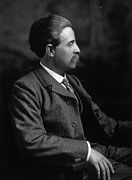Although New York’s Singer Building (149 Broadway, New York City) was lost in the late 1960s, at least two other buildings remain today with strong claims of sisterhood. One is in New York City, just about a mile north of where the lost Singer Building once stood. The other is halfway around the world.
The Little Singer Building (561 Broadway, New York City) was built in 1903. Like the (Big) Singer Building, it designed by the Beaux-Arts-trained architect Ernest Flagg for the Singer Manufacturing company. The Little Singer is an attached, zero-lot-line building, in keeping with traditional urban forms. But, unlike Flagg’s next project, it does not have a freestanding tower. Although it was sandwiched between two other buildings, the architect found ways to make it stand out, including the use of cast-iron, arches, and a recessed bay that gives shape to its distinctive color scheme (red brick and green), which presaged the palette of the Singer Tower. Today, it has a clothing store on the ground floor, with residential units above. Here it is, today:
Singer House (28 Nevsky Prospekt, Saint Petersburg) is located on one of pre-Soviet Russia’s grandest commercial strips — the Nevsky Prospekt. Designed by Pavel Suzor, and completed in 1904, the Singer House is more playful in its Art Nouveau design than either of its Beaux-Arts, New York sisters. Yet, in a less formal way, it expresses a similar tendency to combine solid materials and ornate flourishes in a way that defined the visual themes of the company. The Singer House couldn’t have a tower, because the Czar wouldn’t allow anything to exceed the height of his nearby Winter Palace. Here it is, today:
I never find a site on Google Maps without doing some virtual wandering. Roaming around Saint Petersburg on StreetView makes me want to visit. It’s a beautiful and complex city. I’m often taken aback by the incredible richness and refinement of Russia, and its contrast with the country’s seemingly interminable political harshness. It’s a mystery — which makes it interesting.










